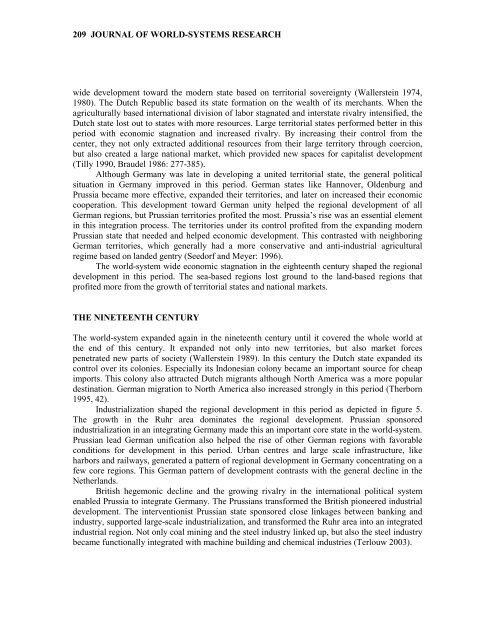Entire Volume 17 issue 1 - Journal of World-Systems Research ...
Entire Volume 17 issue 1 - Journal of World-Systems Research ...
Entire Volume 17 issue 1 - Journal of World-Systems Research ...
You also want an ePaper? Increase the reach of your titles
YUMPU automatically turns print PDFs into web optimized ePapers that Google loves.
209 JOURNAL OF WORLD-SYSTEMS RESEARCH<br />
wide development toward the modern state based on territorial sovereignty (Wallerstein 1974,<br />
1980). The Dutch Republic based its state formation on the wealth <strong>of</strong> its merchants. When the<br />
agriculturally based international division <strong>of</strong> labor stagnated and interstate rivalry intensified, the<br />
Dutch state lost out to states with more resources. Large territorial states performed better in this<br />
period with economic stagnation and increased rivalry. By increasing their control from the<br />
center, they not only extracted additional resources from their large territory through coercion,<br />
but also created a large national market, which provided new spaces for capitalist development<br />
(Tilly 1990, Braudel 1986: 277-385).<br />
Although Germany was late in developing a united territorial state, the general political<br />
situation in Germany improved in this period. German states like Hannover, Oldenburg and<br />
Prussia became more effective, expanded their territories, and later on increased their economic<br />
cooperation. This development toward German unity helped the regional development <strong>of</strong> all<br />
German regions, but Prussian territories pr<strong>of</strong>ited the most. Prussia’s rise was an essential element<br />
in this integration process. The territories under its control pr<strong>of</strong>ited from the expanding modern<br />
Prussian state that needed and helped economic development. This contrasted with neighboring<br />
German territories, which generally had a more conservative and anti-industrial agricultural<br />
regime based on landed gentry (Seedorf and Meyer: 1996).<br />
The world-system wide economic stagnation in the eighteenth century shaped the regional<br />
development in this period. The sea-based regions lost ground to the land-based regions that<br />
pr<strong>of</strong>ited more from the growth <strong>of</strong> territorial states and national markets.<br />
THE NINETEENTH CENTURY<br />
The world-system expanded again in the nineteenth century until it covered the whole world at<br />
the end <strong>of</strong> this century. It expanded not only into new territories, but also market forces<br />
penetrated new parts <strong>of</strong> society (Wallerstein 1989). In this century the Dutch state expanded its<br />
control over its colonies. Especially its Indonesian colony became an important source for cheap<br />
imports. This colony also attracted Dutch migrants although North America was a more popular<br />
destination. German migration to North America also increased strongly in this period (Therborn<br />
1995, 42).<br />
Industrialization shaped the regional development in this period as depicted in figure 5.<br />
The growth in the Ruhr area dominates the regional development. Prussian sponsored<br />
industrialization in an integrating Germany made this an important core state in the world-system.<br />
Prussian lead German unification also helped the rise <strong>of</strong> other German regions with favorable<br />
conditions for development in this period. Urban centres and large scale infrastructure, like<br />
harbors and railways, generated a pattern <strong>of</strong> regional development in Germany concentrating on a<br />
few core regions. This German pattern <strong>of</strong> development contrasts with the general decline in the<br />
Netherlands.<br />
British hegemonic decline and the growing rivalry in the international political system<br />
enabled Prussia to integrate Germany. The Prussians transformed the British pioneered industrial<br />
development. The interventionist Prussian state sponsored close linkages between banking and<br />
industry, supported large-scale industrialization, and transformed the Ruhr area into an integrated<br />
industrial region. Not only coal mining and the steel industry linked up, but also the steel industry<br />
became functionally integrated with machine building and chemical industries (Terlouw 2003).





